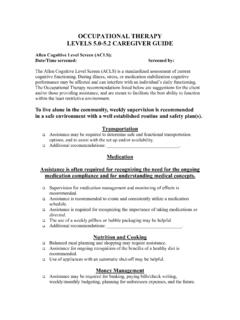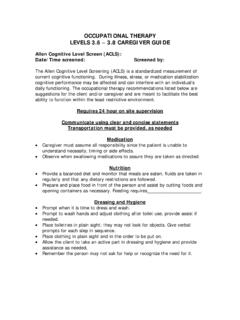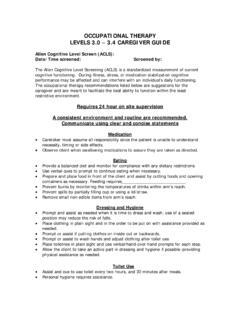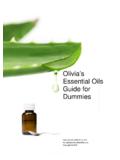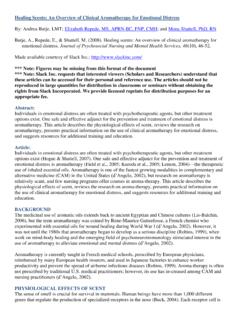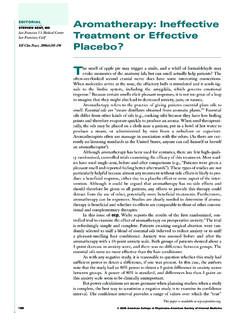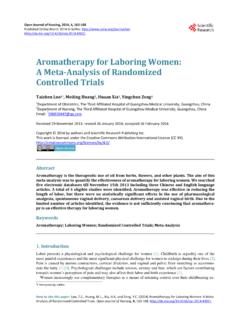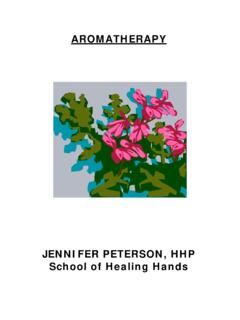Transcription of Aromatherapy Handout revised2 92008 - OT-Innovations
1 1 A r o m a t h e r a p y C l i n i c a l a r o m a t h e r a p y: The use of essential oils for therapeutic purposes, with benefits that may include relief of stress, anxiety, insomnia and a reduced perception of pain. Aromatherapy promotes the processes of self-soothing and self-organization (mind, body and spirit). Essential oils also have significant antimicrobial and skin healing properties. C l i n i c a l a r o m a t h e r a p y is the use of essential oils for specific, measurable outcomes and is research based.
2 N o n-c l i n i c a l a r o m a t h e r a p y is the use of essential oils or scents for aesthetic purposes. E s s e n t i a l o i l s: The steam distillates obtained from various parts of aromatic plants. Essential oils are found in flowers, leaves, woods, barks and peels of many plants. The oils are highly volatile molecules but are very safe when used appropriately. The two most common methods of extracting essential oils are steam distillation and expression. Essential oils need to be mixed with carrier oils ( almond oil) or water.
3 S t e a m d i s t i l l a t i o n: The aromatic plant material is placed on a grid. Highly pressurized steam passes through the plants breaking open tiny aromatic capsules and releasing the oil. The steam/oil mixture is cooled via a condenser and the resulting water/oil mixture is collected. Essential oils are non-soluble in water; therefore, the oil is easily siphoned off the top of the resulting liquid. E x p r e s s i o n: The peels or rinds of citrus fruits are placed on a conveyer belt. The mechanical scrapers puncture the peels and the oils are gathered by centrifugal separation.
4 D i r e c t I n h a l a t i o n : Steam inhalation is the use of essential oils floating on the surface of a bowl of steaming water. The person makes a tent with a towel over the head, shoulders and bowl, then directly inhales through the nasal passages for approximately ten to fifteen minutes. One can also place a drop of essential oil onto a cotton ball or use a vicks-type essential oil inhaler to deliver their therapeutic benefits directly into the nasal passages as needed. 2 I n d i r e c t I n h a l a t i o n: These include plug-in Aromatherapy diffusers, spritzer sprays, aroma lamps, nebulizers/vaporizers.
5 C a u t i o n : A v o i d s t e a m i n h a l a t i o n i f y o u h a v e a s t h m a . T o p i c a l a p p l i c a t i o n: massages, baths (full body, foot and hands), body washes and compresses. S a f e t y G u i d e l i n e s: Must consult with your physician prior to use of any essential oils. Always keep them away from children You need to have knowledge of the use of any essential oils Avoid contact with the eyes Observe for skin irritations Never use undiluted essential oils Pregnant women should take extra care in using essential oils Some essential oils are photosensitive Do not take by mouth Make sure essential oils don t have phenol (can be dermacostic) S t o r a g e o f E s s e n t i a l O i l s.
6 Store them out of reach for children and confused elders Locked in a container Store in a cool dry place away from heat and light Kept in colored glass bottles Kept away from candles, matches, fire and gas cookers Do not sprinkle on top of light bulbs V e nd o r s o f P u r e E s s e n t i a l O i l sHerbarium 264 Exchange ST Chicopee, MA 01013 (413) 598 8119 Natures Gift Aromatherapy Products 314 Old Hickory BLVD East Madison, TN 37115 (615) 612-4270 Compiled by Marie Chalifour, OTR/L, Tina Champagne, OTR/L & Kathleen Duffy, RN Revised 9/2008 Reference: Buckle, J.
7 (2003). Clinical Aromatherapy : Essential oils in practice (2nd Ed.). London: Churchill Livingstone.
